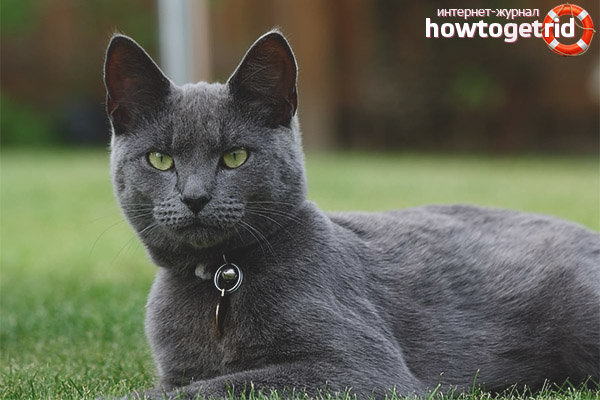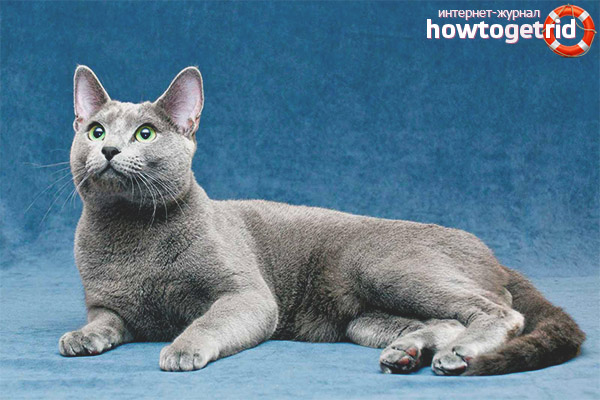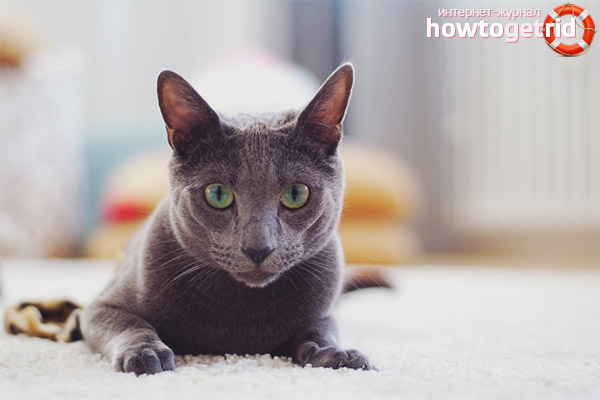The content of the article
- 1 The history of the breed
- 2 Breed standards and its features
- 3 Wool Characteristics
- 4 Colors
- 5 Character Features
- 6 Russian blue cats and children
- 7 Features of care and maintenance
- 8 Health features
- 9 How long do Russian blue cats live?
- 10 How much is a Russian blue cat?
- 11 Where can I buy a Russian blue cat?
- 12 Video: Russian Blue Cat
It is impossible to know for sure about the origin of the breed of Russian blue cats. It is known for certain that this breed is of indigenous origin. Their history is quite old, because the breed appeared back in the 16th century, and even then it spread to France, Spain, Scandinavia, and Great Britain. But judging by the name, the home of the Russian blue is considered to be Russia. Formation of pedigree standards was very long before cats of this breed acquired the present traits of appearance and character.
The history of the breed
The appearance of the Russian blue cat has undergone some changes over time. Breeders crossed them with representatives of other breeds - Siamese, British to obtain ideal pedigree data. This was done so that the breed received better health and the most attractive appearance. With the help of the British, blue cats got a more beautiful coat. But the cross with the Siamese played a cruel joke with the breeders, increasing the negative qualities in both breeds. Therefore, the breeders agreed - to stop the breeding experiments and make every effort to return the Russian blue cats to their original form.
This cat gained the greatest popularity in the twentieth century. This breed of cats was appreciated by the Russians and the rulers, Nicholas 2 and Queen Victoria. They preferred to keep her representatives as pets.
Breed standards and its features
Breed standards of Russian blue have been established for many centuries. Breeders are well aware that through generations of breeding, the appearance of the breed representatives accepts some changes and becomes more attractive to humans. Animal health is also getting better.
Today, a Russian blue cat must meet the following pedigree standards:
- Torso. Cats of this breed are medium in size. The body looks somewhat elongated and graceful. Cats of this breed should be graceful and aristocratic. Individuals with extra pounds are often disqualified at exhibitions and removed from breeding.
- Head. Triangular regular shape. Elongated and elongated.
- Muzzle. The profile should be straight and the forehead flat. When looking in full face, the nose and chin of the cat should be on the same vertical line, without deviation in one direction or another. Malocclusion is an indicator of an animal for exclusion from breeding.
- The ears. They should be widely spaced, large in size and of sufficient length, with a wide base and sharp tips. The ear shells should be pink.
- Paws Must be long, slender and muscular. Part of the paws with pads is medium in size and looks sophisticated in relation to the cat's body.
- Neck. Should not be too narrow or wide. Necessarily smooth.
- Eyes. Must have a green color, be widely planted and large, almond-shaped.
- Tail. Long enough with a tight-fitting coat. Must have a sharp tip.
- Sizes and weight. Russian blue cats are medium in size, the weight of the female is approximately 3.5 kg on average, and the cat is about 5.
The breed standards and its description may have some differences for different systems for assessing breed characteristics, while respecting the main features of the Russian blue cat. Today, breeders have a priority in preserving the breed in its original form.
Wool Characteristics

Cats of this breed have wool, well-groomed by nature. It should be smooth, silky and healthy. Hairy dense texture. The coat should be the same length throughout the body of the animal with a dense undercoat. It is needed to maintain the desired temperature of the cat's body and protect it from moisture. The hair of the undercoat should match the color with the shade of the entire hairline of the animal.
Colors
The Russian blue cat most often corresponds to its name, therefore the main tone of the fur of these animals is blue. It can be very light and almost dark. It does not matter much, the main thing is that it is blue. Many breeders are engaged in breeding the ideal shade of hair in cats of this breed.
Character Features
The Russian blue cat is a typical aristocrat not only in appearance, but also in the inner world. They have a phlegmatic temperament. Perfectly balanced, obedient and extremely calm. They are distinguished by a strong attachment to their own owners, for the sake of which they are ready for anything. Russian blue people are distinguished by their extraordinary intelligence, as well as intelligent manners. They respond well enough to training and quickly get used to changes in conditions of detention. Their most famous feature is undeniable love and devotion to the owner.
A huge plus is that the Russian blue cat perfectly tolerates loneliness. Of course, they miss their master, but do not experience stress in his absence.
Cats of this breed are extremely curious and curious. They are interested in the world around and everything that is in it, whether it be new territories, animals, plants or objects. It will never be difficult for the owner to take a pet if he is a representative of Russian blue cats.
More representatives of this aristocratic and sophisticated breed are excellent hunters. This is noted by all owners of representatives of this breed. No mouse or bird can hide from Russian blue. Owners should consider this when keeping cats of this breed in the house along with other animals.
Russian blue cats and children
A positive distinguishing feature of the representatives of this cat breed is that they just treat children very well. The Russian blue cat is very patient and condescending. Therefore, she is not only a faithful friend of her master, but also a very good nanny for young children.
Often, domestic cats perceive human children in the same way as kittens of their relatives. The animal clearly realizes that it is a child. But, of course, there are exceptions. It all depends on the individual characteristics of the character of the pet. Nevertheless, the cats of the Russian blue breed are distinguished by special patience, calmness and poise. Among cats, there is no better friend for the baby than a Russian blue cat.
Features of care and maintenance
Russian blue cat is unpretentious in maintenance and care. She has a short coat that does not require complicated care. It is enough to bathe it once every six months (not more often) or as absolutely necessary. Cats of this breed are quite clean and can independently maintain themselves in proper shape.
It is necessary to comb the cat in order to remove the lost hair on its own. This will not only help the animal, but also contribute to maintaining cleanliness in the house. This should be done with a soft or silicone brush, as well as a comb with small cloves.
To protect the pet from possible infection with parasites and fleas, he can purchase a special collar. For preventive purposes, deworming should be carried out approximately every 6 months, with the help of complex-acting preparations (namely, on round and tapeworms). This should be done with the help of special drugs purchased at a veterinary pharmacy, in compliance with the dosage, based on the weight of the pet. Some mistakenly believe that a cat living in a house or apartment without going outside cannot get infected with worms. However, this opinion is very erroneous. Parasites can enter the body of an animal from poorly thermally processed meat, fish, from other animals and even from the host.
A cat’s teeth must also be brushed. You need to do this once or twice a week with a special paste and brush. You need to train a kitten to brush your teeth from a very young age, but you can also train a cat to grow up. To do this, you need to take a paste and a brush. Moisten the brush with water and apply a very small amount of special cat paste on it. To fix the cat with one hand, gently keeping its mouth open with the fingers. Use your other hand to brush the hygiene procedures. With flicking movements with a light touch, you first need to clean the fangs, and then all the other teeth. Particular attention should be paid to the teeth located in the corners of the mouth. If the animal is very indignant when brushing his teeth, then you should not blame him for the bad character, maybe he just has sensitive teeth.
Health features
Thanks to competent centuries-old selection and good conditions, the Russian blue cat is distinguished by good health and good life expectancy. In representatives of this breed, genetic pathologies and diseases are very rare.
Unfortunately, the Russian blue cat loves to eat deliciously. Therefore, you should control the quality and quantity of food consumed by her, so that there are no problems with extra pounds. Excess weight has not yet made anyone more attractive and healthy, including Russian blue cats.
Certain abnormalities can occur from the bones and teeth of a cat. To avoid this, the animal's diet should be balanced and complete. If there is no way to prepare a quality food for your pet yourself, then you need to choose high-quality feed with vitamin and mineral complexes.
When feeding cats with natural food, nutrition may not always be balanced and beneficial. In this case, it is better to add complex vitamins to the diet in order to maintain the health of the pet in the norm.
How long do Russian blue cats live?

Russian blue cat is a feline long-liver. Representatives of this breed live long enough and can live even up to twenty years, subject to good nutrition and living conditions. Since they have good health, they remain active until the last days of life. On average, the life span of a Russian blue cat is about 17 years.
How much is a Russian blue cat?
Be sure to carefully consider the choice of sex of the cat. Males usually cost less than females.It should be borne in mind that when buying an animal of a certain gender for breeding, it will be necessary to provide conditions - for the cat - for breeding, for the cat - for raising kittens.
Where can I buy a Russian blue cat?
Of course, it is better to buy a thoroughbred kitten in a specialized nursery or at exhibitions. Due to the prevalence of the breed in the countries of the former Soviet Union, it is unlikely that there will be any difficulties finding kittens. There are breeders of Russian blue cats in almost all major cities of Russia and Ukraine.
However, if in the city of residence the future owner did not find a baby of this breed, you should not buy the animal remotely. It is better to visit the cattery on your own to see the conditions in which the cats are kept, look at all the documents and carefully examine the future pet before buying. Perhaps this will require a little time and additional costs. Nevertheless, a personal meeting with sellers during the transaction will help to understand whether it is worth buying a kitten from him.
Video: Russian Blue Cat











Submit